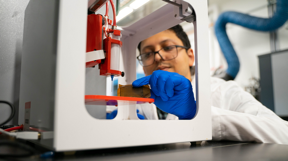Home > Press > UBCO researchers change the game when it comes to activity tracking: Flexible, highly sensitive motion device created by extrusion printing
 |
| UBC Okanagan doctoral student Ahmadreza Ghaffarkhah uses a 3D printer to create small and highly-accurate sensors that can be integrated into clothing and equipment.
CREDIT UBC Okanagan photo |
Abstract:
The creation of high-resolution extrusion printingthink 3D printing but with ink that conducts electricityhas enabled UBC researchers to explore the potential of wearable human motion devices.
UBCO researchers change the game when it comes to activity tracking: Flexible, highly sensitive motion device created by extrusion printing
Kelowna, BC Canada | Posted on June 17th, 2022
Wearable technologysmartwatches, heart monitors, sleep aid devices, even step countershave become part of everyday life. And researchers with UBC Okanagans Nanomaterials and Polymer Nanocomposites Laboratory, have created even smaller, lighter and highly-accurate sensors that can be integrated into clothing and equipment.
In collaboration with Drexel University and the University of Toronto, the UBCO research team is exploring a high-resolution extrusion printing approach to develop tiny devices with dual functionalityelectromagnetic interference (EMI) shields and a body motion sensor.
Tiny and lightweight, these EMI shields can have applications in the health care, aerospace and automotive industries, explains Dr. Mohammad Arjmand, Assistant Professor and Canada Research Chair in Advanced Materials and Polymer Engineering at UBC Okanagan’s School of Engineering.
Using a two-dimensional inorganic nanomaterial called MXene, alongside a conductive polymer, Dr. Arjmands team has customized a conductive ink with a number of properties that make it easier to adapt into wearable technologies.
Advanced or smart materials that provide electrical conductivity and flexibility are highly sought-after, he says. Extrusion printing of these conductive materials will allow for macro-scale patterning, meaning we can produce different shapes or geometries, and the product will have outstanding architecture flexibility.
Currently, manufacturing technologies of these functional materials are mostly limited to laminated and unsophisticated structures that dont enable the integration of monitoring technologies, explains doctoral student Ahmadreza Ghaffarkhah.
These printed structures can be seeded with micro-cracks to develop highly sensitive sensors. Tiny cracks in their structures are used to track small vibrations in their surroundings, says Ghaffarkhah. These vibrations can monitor a multitude of human activities, including breathing, facial movements, talking as well as the contraction and relaxation of a muscle.
By going back to the drawing board, the UBCO researchers were able to address a major challenge encountered by extrusion printing. Previously, the technology didn’t allow for high-enough printing resolution, so it was difficult to manufacture highly precise structures.
Compared to conventional manufacturing technologies, extrusion printing offers customization, reduction in materials waste, and rapid production, while opening up numerous opportunities for wearable and smart electronics, explains Dr. Arjmand. As extrusion printing techniques improve, it is opening the door to many unique innovations.
The researchers continue to investigate additional applications for extrusion printing inks that go beyond EMI shields and wearable electronics.
The research was published in Carbon, with financial support from a Natural Sciences and Engineering Research Council of Canada Alliance Grant and Zentek Limited.
####
For more information, please click here
Contacts:
Patty Wellborn
University of British Columbia Okanagan campus
Cell: 250-317-0293
Copyright © University of British Columbia Okanagan campus
If you have a comment, please Contact us.
Issuers of news releases, not 7th Wave, Inc. or Nanotechnology Now, are solely responsible for the accuracy of the content.
2 Dimensional Materials
![]()
Controlled synthesis of crystal flakes paves path for advanced future electronics June 17th, 2022
![]()
Solving the puzzle of 2D disorder: An interdisciplinary team developed a new method to characterize disorder in 2D materials June 17th, 2022
![]()
Bumps could smooth quantum investigations: Rice University models show unique properties of 2D materials stressed by contoured substrates June 10th, 2022
![]()
UCI scientists turn a hydrogen molecule into a quantum sensor: New technique enables precise measurement of electrostatic properties of materials April 22nd, 2022
3D & 4D printing/Additive-manufacturing
![]()
Nanoscale lattices flow from 3D printer: Rice University engineers create nanostructures of glass and crystal for electronics, photonics October 15th, 2021
![]()
Dynamic 3D printing process features a light-driven twist: Light provides freedom to control each layer and improves precision and speed February 4th, 2021
![]()
Russian scientists improve 3D printing technology for aerospace composites using oil waste November 27th, 2020
Govt.-Legislation/Regulation/Funding/Policy
![]()
University of Illinois Chicago joins Brookhaven Lab’s Quantum Center June 10th, 2022
![]()
Bumps could smooth quantum investigations: Rice University models show unique properties of 2D materials stressed by contoured substrates June 10th, 2022
![]()
Nanostructured fibers can impersonate human muscles June 3rd, 2022
Discoveries
![]()
New nano-gel to protect children receiving chemotherapy from hearing loss June 17th, 2022
![]()
Scientists offer solutions for risky tap water June 17th, 2022
![]()
Solving the puzzle of 2D disorder: An interdisciplinary team developed a new method to characterize disorder in 2D materials June 17th, 2022
Announcements
![]()
Photonic integrated erbium doped amplifiers reach commercial performance: Boosting light power revolutionizes communications and autopilots June 17th, 2022
![]()
OCSiAl expands its graphene nanotube production capacities to Europe June 17th, 2022
Water
![]()
Scientists offer solutions for risky tap water June 17th, 2022
![]()
Organic water splitters get a boost June 10th, 2022
![]()
The future of desalination? A fast, efficient, selective membrane for purifying saltwater May 13th, 2022
Grants/Sponsored Research/Awards/Scholarships/Gifts/Contests/Honors/Records
![]()
New nano-gel to protect children receiving chemotherapy from hearing loss June 17th, 2022
![]()
Nanostructured fibers can impersonate human muscles June 3rd, 2022
![]()
Bacteria-killing drills get an upgrade Visible light triggers: Rices molecular machines to treat infections June 1st, 2022
![]()
A new step in the search for room-temperature superconductors May 27th, 2022










